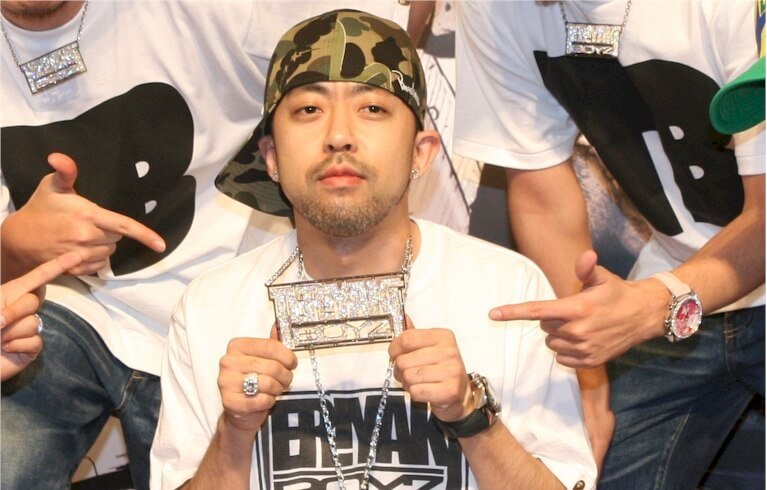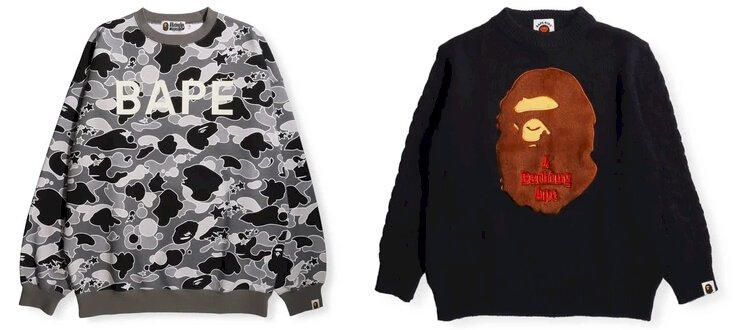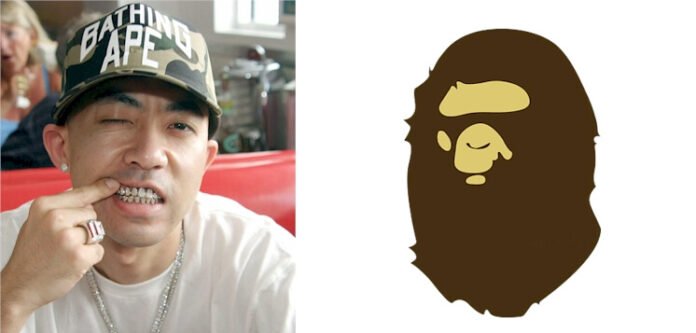Let’s get an insight into the BAPE logo and some history behind the Japanese clothing brand.
In 1993, Nigo introduced the BABE line of clothing to the world. After studying fashion editing at Bunka Fashion College, he stepped out to change the fashion industry. Working with his friend, Jun Takahashi, they formed Nowhere in Tokyo, Japan.
And thinking of a name, he drew inspiration from the movie—Planet of Apes. Finally, he settled for the brand name—A Bathing Ape. Its short form is BAPE, ironically pointing to the wealthy young Japanese who loved pampering themselves. Initially, these were the audience.
To craft a brand identity, he settled for an awe-inspiring Bape logo. This visual ambassador comprised a head of an ape and a text. The human-like symbol is covered with dark brown hair. Also, yellow marks its central part, revealing its eyes, nose, mouth, cheek, etc.
The company uses the Bape logo on all promotional materials. From t-shirt to footwear, you’ll hardly miss this iconic emblem. Overall, it has been an effective logo.
BAPE Logo History And Evolution
1993 – PRESENT
Planet of Apes, a 1968 movie, inspired the brand’s name, BAPE. The Bape logo was released in 1993. The emblem is an abstract head of an ape with two colors. First, a yellow color paints the forehead, eyes, nose, mouth, and cheek. Then, the rest of the image is covered in dark brown color. This iconic logo is called Cloud Camo, and its brand’s name stands for—A Bathing Ape.
Why Does BAPE Logo work?
1. The Emblem Is Unique:
You want to position your brand above your rivals. And that’s why you need to have a custom logo that sets you apart from others. Fortunately, the BAPE logo is exceptional—there’s no logo in the industry that shares a similar personality. Therefore, it makes it easy for customers to pick it from the crowd. To make your brand shine, employ this attribute in your logo design.
2. The Emblem Is Simple:
The BAPE emblem has fewer graphic elements. It has text and a neat icon. And this makes it look elegant and powerful. For keeping this quality, the logo became highly recognized and memorable. So, to create your logo, focus on the values you want to convey to your audience.
3. The Emblem Is Memorable:
The power of uniqueness and simplicity leads to memorability. Never forget this statement! However, it takes time and effort to imprint your brand in the minds of people. But since the BAPE logo is unique and straightforward, it became unforgettable. So the net impact is—a strong emotional connection between the brand and its customers.
4. The Emblem Is Scalable:
The 21st century has given customers several channels to spend their time and access relevant information. Therefore, to reach out to your audience, your logo should fit such marketing mediums. Luckily, the BAPE emblem can render to any size without losing its quality. Thanks to its minimalist layout, it can dress on any advertising platform.
5. The Emblem Is Legible:
A font is essential in logo design. It conveys the values and tones of the brand while spelling out its name. Therefore, you can use it to evoke any emotion that relates to your brand’s personality. Luckily, the BAPE logo is legible, helping its audience to read and process it. Remember, a wrong font choice will push customers away from you.
BAPE Logo Design Elements

The creative brain behind the BAPE logo understands the principles guiding effective logo designs. Therefore, he picked his design elements with caution. He chose a rare abstract symbol and two colors to tell the brand’s unique story and identity. To pick his brain, kindly read on.
BAPE Logo Shape And Symbols
An Ape:

The only recognizable symbol on the BAPE logo is the face of an ape. It symbolizes the affluent lifestyle of Japanese youth who pamper themselves by bathing in warm water. So, this led to the phrase—A Bathing Ape in Lukewarm Water.
People who are familiar with Japanese culture will relate to this aspect of their grand tradition. More so, an ape is a symbol of ugliness, bullying, and malice. But, on the positive side, it represents confidence, fearlessness, independence, persistence, and intelligence.
BAPE Logo Colors
1. A Yellow Color:
Yellow is a color of joy. It forms the central part of the logo, and it reveals the eyes, mouth, nose, and forehead. The color of sunshine, yellow, represents clarity, honor, and loyalty. However, it can also symbolize intellect, happiness, and freshness.
2. A Brown Color:

Brown is an earthen color. So it stimulates our taste buds. It covers every part of the head on the emblem, leaving the eyes, mouth, nose, and forehead visible. In art, brown signifies reliability, elegance, security, and healing. Also, it can convey stability, honesty, and simplicity.
What Font Is BAPE Logo?
Though the abstract image always comes untouched, the brand has used varying typefaces over the years. However, the most frequent font used is like the College font. So, if you want to mimic the BAPE logo font, try the College type.
What Does the BAPE Logo Mean?
The BAPE logo is the head of an ape. But you can find its meaning by splitting its brand’s name—BAPE. Here, the letter—B stands for bath, leaving the name of the creature. So, BAPE is the shortened form of the caption—A Bathing Ape in Lukewarm Water.
What Color Is the BAPE Logo?
BAPE has two traditional colors—yellow and dark brown. The yellow color paints the central part of the image. Here, it reveals the famous creature’s eyes, nose, mouth, forehead, and cheek. Then, the dark brown color takes the dominant part, representing the facial hair of the beast.
Why Is BAPE So Expensive?
You know, in business, demand and supply determine the price of a product. And as long as customers are craving for such a product, naturally, its price will rise. This is the same driving force behind the price of BAPE products.
The demand for BAPE apparel is so high you can hardly find one in stock. So yes, customers picked them up quickly. Similarly, the demand is further fueled by the marketing hype around the brand. Nigo has a lot of influential associates, so he benefits from their loyal followers.
What Is BAPE SHARK?

Since it started in 1993, the Japanese clothing company has released several designs into the market. And one of such brands is the BAPE Shark hoodie. It’s a mixture of style and unusual attention-grabber. In creating this hoodie, the designer got inspiration from a military fighter plane. Commercially, it’s one of the most popular products the company has made.
What Is the BAPE Slogan?
The Japanese clothing brand enjoys using catchy phrases to promote its line of apparel. However, while most people know its iconic caption—A Bathing Ape in Lukewarm Water, very few see the brand’s slogan. So, there you have it—Ape shall never kill ape. Still, this slogan references the 1968 movie that inspired the brand’s famous name—BAPE.
What Does BAPE Logo Mean?
You wouldn’t be wrong to infer that BAPE is an acronym, Bathing Ape. But, again, the caption resonates with a movie and a Japanese idiom. First, the emblem pays tribute to the film—Planet of the Apes. Second, it echoes the Japanese expression that states—A Bathing Ape in Lukewarm Water. Interestingly, this saying references the young wealthy Japanese, its initial targets.
When Did BAPE Start?
BAPE started in 1993 in Tokyo, Japan. With a four million Japanese yen loan, Nigo and his friend, Jun Takahashi, formed a company and named it—Nowhere. They opened the first store in Ura-Harajuku district, a commercial fashion community.
Who Is Nigo?

Nigo is a Japanese fashion designer, record producer, and DJ for the hip-hop band Teriyaki Boyz. At birth, his parents named him Tomoaki Nagao. The dynamic entrepreneur was born on December 23, 1970. He is famous for creating the urban fashion brand—A Bathing Ape.
He studied fashion editing at Bunka Fashion College. He met Jun Takahashi, his business partner, at this school. But before starting Nowhere, he worked for Popeye magazine as an editor. Then, in April 1993, he opened his first store with a loan of four million yen.
Nigo located this store at Ura-Harajuku, a buzzing fashion center. He named his brand—A Bathing Ape after the movie, Planet of the Apes. Funny enough, the name has an emotional connection with Japanese culture. So, the brand became popular nationwide.
Frequently, Nigo has given credit to those who inspired him. At the top of the list are his parents, a nurse, and a billboard maker. Next, he has cited the fashion guru Hiroshi Fujiwara as his business model. Then, we have Elvis, the Beatles, and the Run-D.M.C, to list a few.
Nigo designed and unveiled the Bapesta sneaker in 2002. The sneaker, though without the swoosh sign, resembles Nike’s Air force One design. Three years later, he partnered with Pharrell Williams to design and release Billionaire Boys Club and Ice Cream.
Nigo believes in collaborations, hence, working with top brands and artists. Over the years, he’s teamed up with Coca-Cola, Pepsi, Adidas, Kanye West, Soulja Boy, Biggie, etc. In 2020, he teamed up with Louis Vuitton and Virgil Abloh to design a capsule collection.
Finally, his hard work hasn’t gone unnoticed. In 2005, he received the MTV Asia Style Award. Then, fifteen years later, he received the 2020 GQ Fashion Designer of the Year Award.
A Short History About BAPE Clothing Brands

Tomoaki Nagao, famously called Nigo, founded BAPE. In 1993, he opened the first store, Nowhere, in the Ura-Harajuku district of Tokyo, Japan. So, A Bathing Ape is a Japanese clothing brand that uses hype and scarcity to promote its line of products.
Nigo is a movie enthusiast. One day while watching the film—Planet of the Apes, he got the idea for his brand. So he created the emblem of the brand and tagged it—A Bathing Ape.
While the 1968 movie inspired the name, it aligns with the Japanese idiom—A Bathing Ape in Lukewarm Water. Ironically, it references the lifestyle of the younger wealthy Japanese, the brand’s audience. In Japan, it’s common to find people bathing in water at 40 degrees Celsius.
The brand specializes in children’s wear, men’s wear, and women’s lifestyle and streetwear. Working in partnership with Jun Takahashi, Nigo unveiled about fifty BAPE t-shirts on launch day. Interestingly, two factors accounted for this limited quantity: scarcity and limited funds.
Though Nigo was on a tight budget, he believed in the power of scarcity. So, it was his marketing strategy to honor about 10% of the demand. Eventually, this gave the brand a premium status. For two straight years, Nigo made thirty to fifty shirts weekly.
Tactically, half of these limited quantities went to influencers in Tokyo to hype the brand. It worked as planned! By 1998, the brand was in about forty stores in Japan.
To centralize its effort, he cut all distribution ties, focusing on a single location. With this step, BAPE became hard to find, increasing its price. According to him, the sales from one store were as good as sales from the entire location. It means he didn’t regret taking such a decision.
Nigo, in 1997, unveiled his debut album—Ape Sounds. And working with DJ James Lavelle, they promoted the brand heavily. Also, Notorious BIG became one of the biggest rappers to endorse the brand. Also, the start of the year 2000 elevated the BAPE brand even further.
Jacob the Jeweler introduced Nigo to Pharrell Williams. In 2005, the two musicians worked on the Billionaire Boys Club and Ice Cream Clothing lines. This led to stores in New York and Los Angeles, marking the first BAPE stores outside Japan.
Now, A Bathing Ape has entered American hip-hop fashion. Kanye West was another rapper who increased the hype of the brand. In 2007, he designed a custom edition of the Bapesta sneakers. Then, on February 1, 2011, IT Group, a Hong Kong fashion giant, bought BAPE.
The deal amounted to $2.8 million. However, Nigo didn’t leave immediately. He stayed until 2013 as the Creative Director. Why the sale if BAPE was profitable? Well, by 2010, the brand was out of vogue and in massive debt, about $22.5 million.
Besides collaborating with musicians, the brand has worked with some iconic companies too. We can talk of Coca-Cola, Pepsi, Nintendo, Adidas, and Rimowa, to list a few.
My Final Thoughts On the Bape Logo
Nigo is a Japanese fashion entrepreneur and a musician. At birth, he earned the name Tomoaki Nagao. In 1993, he borrowed money from a friend to start his fashion line. Teaming up with his college mate, Jun Takahashi, they named the business Nowhere.
And to give the product a premium status, he made it scarce. For instance, in the first two years, he made about fifty items weekly. After that, however, he sells half of the apparel, giving the rest to influencers. His marketing strategy worked, increasing the brand’s image and revenue.
Nigo’s working relationship with some top musicians also heightened the brand’s reputation. A few of these stars were Soulja Boy, Notorious BIG, Pharrell Williams, etc. Finally, after owning the company for eighteen years, he sold it to IT Group for about $2.8 million.
To help with the transition, he stayed for two years, working as the Creative Director. Then, in 2014, he became the manager and producer of BILLIE IDLE, a female pop band. Then, finally, in September 2021, Kenzo appointed him as its Artistic Director.







